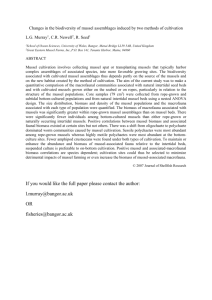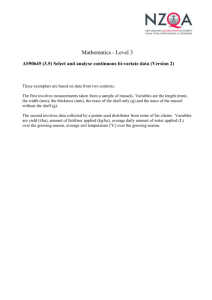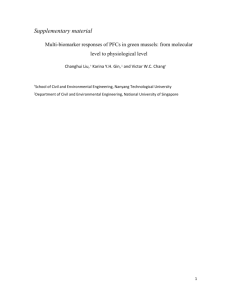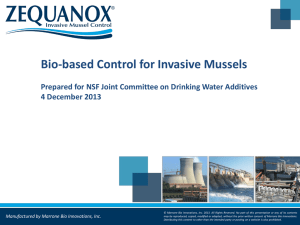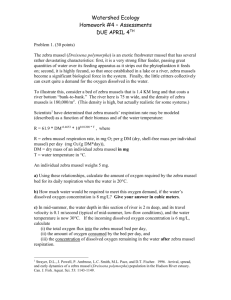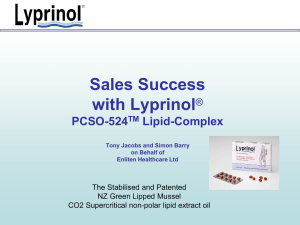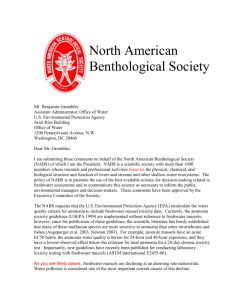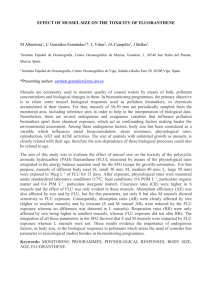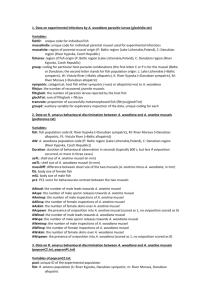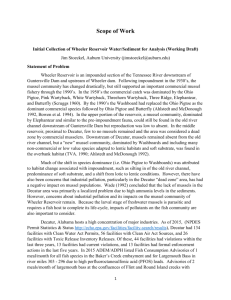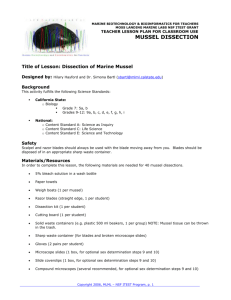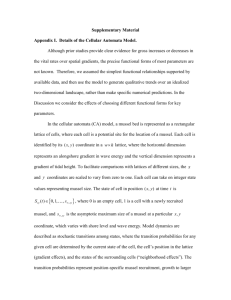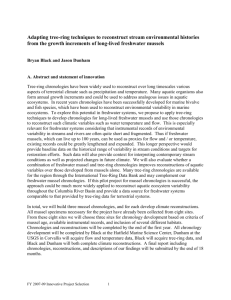Statement of Interest W912HZ-15-SOI-0029 Project to be initiated in
advertisement
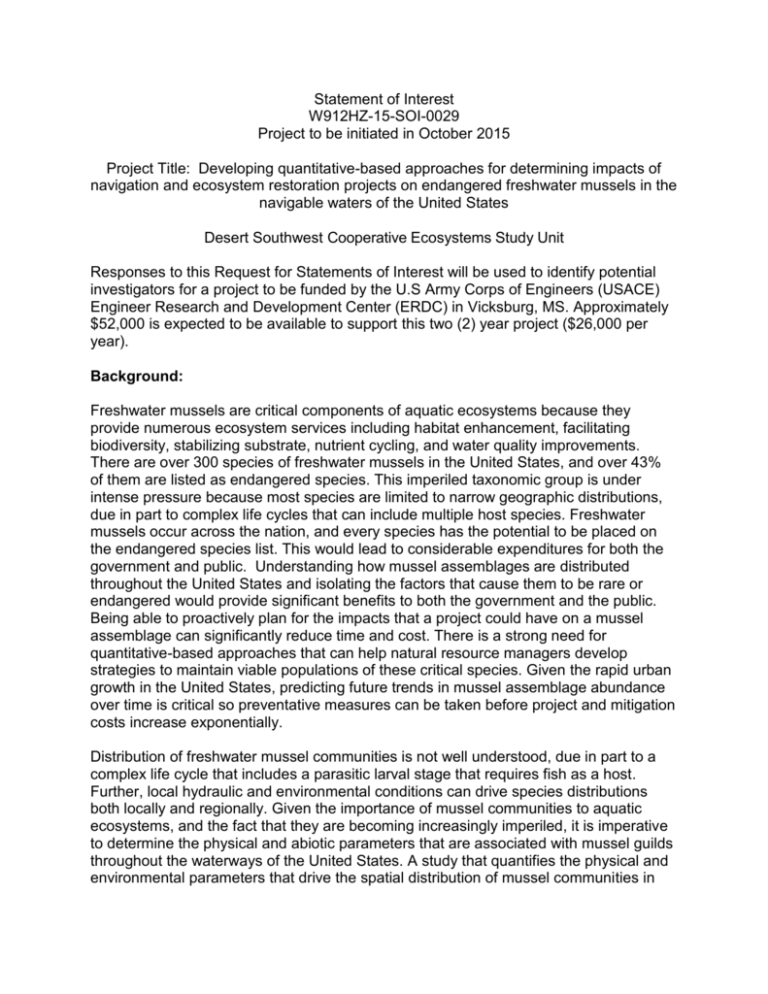
Statement of Interest W912HZ-15-SOI-0029 Project to be initiated in October 2015 Project Title: Developing quantitative-based approaches for determining impacts of navigation and ecosystem restoration projects on endangered freshwater mussels in the navigable waters of the United States Desert Southwest Cooperative Ecosystems Study Unit Responses to this Request for Statements of Interest will be used to identify potential investigators for a project to be funded by the U.S Army Corps of Engineers (USACE) Engineer Research and Development Center (ERDC) in Vicksburg, MS. Approximately $52,000 is expected to be available to support this two (2) year project ($26,000 per year). Background: Freshwater mussels are critical components of aquatic ecosystems because they provide numerous ecosystem services including habitat enhancement, facilitating biodiversity, stabilizing substrate, nutrient cycling, and water quality improvements. There are over 300 species of freshwater mussels in the United States, and over 43% of them are listed as endangered species. This imperiled taxonomic group is under intense pressure because most species are limited to narrow geographic distributions, due in part to complex life cycles that can include multiple host species. Freshwater mussels occur across the nation, and every species has the potential to be placed on the endangered species list. This would lead to considerable expenditures for both the government and public. Understanding how mussel assemblages are distributed throughout the United States and isolating the factors that cause them to be rare or endangered would provide significant benefits to both the government and the public. Being able to proactively plan for the impacts that a project could have on a mussel assemblage can significantly reduce time and cost. There is a strong need for quantitative-based approaches that can help natural resource managers develop strategies to maintain viable populations of these critical species. Given the rapid urban growth in the United States, predicting future trends in mussel assemblage abundance over time is critical so preventative measures can be taken before project and mitigation costs increase exponentially. Distribution of freshwater mussel communities is not well understood, due in part to a complex life cycle that includes a parasitic larval stage that requires fish as a host. Further, local hydraulic and environmental conditions can drive species distributions both locally and regionally. Given the importance of mussel communities to aquatic ecosystems, and the fact that they are becoming increasingly imperiled, it is imperative to determine the physical and abiotic parameters that are associated with mussel guilds throughout the waterways of the United States. A study that quantifies the physical and environmental parameters that drive the spatial distribution of mussel communities in both lentic and lotic systems will help to understand the complex relationships between mussels and their environment. The results of this study can be used to develop an ecological model that will empower natural resource and project managers to develop management strategies that can sustain populations of these critical aquatic species. Brief Description of Anticipated Work: This research shall benefit the public because the management and protection freshwater mussels are important to maintaining the overall health of aquatic ecosystems. For example, freshwater mussels improve water quality by filtering out potentially harmful compounds from the water column. This allows the public to continue have access to recreational lakes that are suitable for fishing. The results of this study shall be published in a peer-reviewed journal article that will provide others with a comprehensive study on the physical and environmental parameters that influence the distribution of freshwater mussels. Furthermore, an ecological model shall be developed that others can use to develop management strategies that can sustain populations of these critical aquatic species. This research project shall focus on developing quantitative models that correlate physical and environmental parameters to the spatial distribution of mussel guilds throughout the United States. A database of known mussel guilds shall be established. Data shall be collected on local habitat factors, especially hydraulic parameters. Sites shall be monitored for mussel distribution. Remotely sensed data such as channel slope, inundation regimes and extend, Lidar imagery, and other available data sources shall be collected. The overall objective is to provide a multiscale spatial and temporal analysis of hydraulic habitats that integrates important local hydraulic variables such as shear stress and Reynolds numbers with reach scale metrics such as slope, confinement, inundation area, riparian buffers, land use, and dam location. Available data on distribution of mussels, hydraulic measurements, and landscape habitat factors shall be used to develop a predictive model for mussel presence. Once this model has been thoroughly evaluated, it could be used to make mussel surveys more efficient and effective, significantly reducing overall expenditures and the model could then be used to focus mussel surveys to sites that have a high probability of mussel presence. Objectives: The objectives of the project for Year 1 are: 1. Gather available remotely senses data for spatial analyses on: 1) mussel and fish distribution, 2) available measured microhabitat data, 3) elevation data to compute channel slope, confinement, inundation regimes and extent, 4) soil data to assess size and connectivity to floodplain, 5) land cover and land use within relevant riparian zones 2. Determine potential field survey locations using a GIS based spatial analysis. The analysis will examine existing mussel distribution data in light of the local, reach and basin scale characteristics noted in Task 1, to develop a working hypothesis on high probability of mussel presence and absence using multivariate analyses. This shall include factors such as slope, distance from confluence, distance from dams, confinement versus changes in inundation area (an index of hydraulic channel heterogeneity and stability) as well as other spatial attributes 3. Generate a peer-reviewed journal article or articles in conjunction with ERDC researchers. The objectives of the project for Year 2 are as follows: 1. Analysis of data on mussel distribution and hydraulic habitat. Measured hydraulic data and mussel distribution data will be used to update our spatial database. The spatial distribution of mussels will be also analyzed in relation to distance with dams, location in stream network (e.g., confluences, subwatershed size, stream order etc.), landscape habitat factors (e.g., land use in riparian zone), and host fish distribution. 2. Develop predictive model. Data collected in the field from the first year in combination with landscape variables gathered for spatial analysis (Year 1, Task 1) shall be used to develop a predictive model. Potential predictors include a measure for substrate stability, inundation during drought, channel slope, land cover in riparian zone. 3. Evaluate model developed in Year 2 - Task 2, using state-of-the-art evaluation techniques 4. Apply model to determine potential spatial distributions of mussel communities. 5. Generate a peer-reviewed journal article or articles in conjunction with ERDC researchers. Requirements: Successful applicants should have expert knowledge with mussel ecology, statistics, and hydrodynamic modeling, as well as related work experience in developing and fieldbased studies on freshwater mussels. Candidates need prior experience with statistical analysis and ecological theory on mussel dynamics. Candidates will be required to submit monthly status reports and a final (annual report) within 4 months of completion of the field and modeling studies. ERDC and the candidates will develop a draft of the journal article or articles for internal peer review before the end of FY16 for Year 1, and FY17 for Year 2. Field studies will occur in Central Texas (the USACE-SWF region), so applicants should be located within the region for field studies. Government Participation: The ERDC will work cooperatively with the investigator to identify issues related to experimental design and model development, and mussel issues facing USACE. ERDC scientists will provide will provide any training for the candidates on model usage, and will participate in the preparation of peer-reviewed journal papers to insure wide dissemination of these findings. Materials Requested for Statement of Interest/Qualifications: Please provide the following via e-mail to: Amanda.Andrews@usace.army.mil (maximum length 2 pages, single spaced 12 pt. font) 1) Name, Organization and Contact Information 2) Brief Statement of Qualifications including: a. Biographical Sketch b. Relevant past projects and clients with brief description of project c. Staff, faculty and students available including area of expertise d. Brief description of capabilities to successfully complete this project Note: A proposed budget is NOT requested at this time. Review of Statements Received: Based on a review of the Statements of Interest received, an investigator or investigators will be invited to prepare a full study proposal. Statements will be evaluated based on investigators specific experience and capabilities in areas related to the study requirements. Additionally, the evaluation method and selection criteria for research and development awards must be: 1) The technical merits of the proposed research and development; and 2) Potential relationship of the proposed research and development to the Department of Defense missions. Please send responses or direct questions to: Amanda Andrews U.S. Army Engineer Research and Development Center (ERDC) ERDC Contracting Office (ECO) 3909 Halls Ferry Rd. Vicksburg, MS 39180 email address: Amanda.Andrews@usace.army.mil Timeline for Review of Statements of Interest: Review of Statements of Interest will begin after the SOI has been posted on the CESU website for 10 working days.
